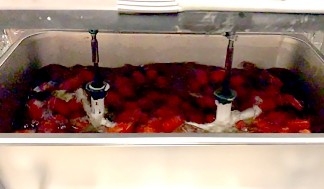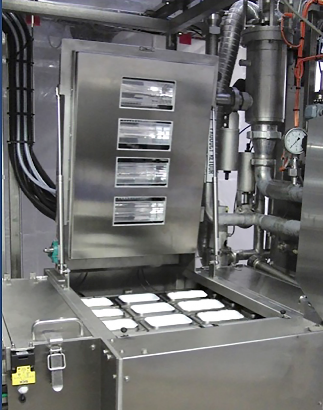How Is Pulsed-Light Used To Process Foods?
ID
FST-357P
Background
Pulsed light (PL) is a food processing technology in which intense, short-duration pulses of white light are used to kill bacteria on food, food contact surfaces, and packaging. The term “pulsed light” is short for and synonymous with “high-intensity broad-spectrum pulsed light,” “pulsed UV light,” and “pulsed white light.” This technology is often used in the cosmetics industry also.
How It Works
PL uses light frequencies from the electromagnetic spectrum (ultraviolet, visible, and infrared; fig. 1), ranging from about 200 to 1,000 nanometers (John and Ramaswamy 2018). Because visible light is a component of PL technology, humans are able to see it working. PL can be delivered in different ways: a single pulse of light, a burst of pulses, continuous pulses, or random sequences (John and Ramaswamy 2018). The radiation from the UV light damages the bacterial DNA (genetic makeup); (Nicorescu et al. 2013. Bacteria and other pathogens can also overheat and be destroyed by absorbing UV light (Elmnasser et al. 2007).

Technology
PL systems are generally made up of three major components: (1) the power supply, (2) a pulse-producing device, and (3) a lamp. Stored energy is released into the lamp, which is then converted into an intense pulse of light onto the food being treated (Elmnasser et al. 2007). Additionally, water used in water-assisted PL (fig. 2) can also be used to cool treated produce while ensuring uniform exposure of all produce surfaces to the light (Huang et al. 2015).

Efficacy
PL does not penetrate foods well and therefore is often only used for surface decontamination. The technology reduces pathogenic E. coli and Salmonella on raspberries by approximately 99.99% (a 4-log reduction); (Xu and Wu 2016). Factors contributing to the effectiveness of PL include light intensity, number of light pulses, and the pattern of the pulses. Particle size, transparency (i.e., opaqueness), and food composition are all factors of a food product that can also affect efficacy. For example, PL does not work well on high-protein or oily foods because the proteins and oils absorb the radiation from the UV light, which interferes with killing pathogens (Elmnasser et al. 2007).
Benefits
In addition to its food safety implications, PL can reduce allergens and extend shelf life while still maintaining product quality (John and Ramaswamy 2018). PL can preserve food quality attributes better than continuous light; because the pulsing prevents constant light exposure, resulting in lower temperatures and, therefore, less heat damage (Krishnamurthy, Demirci, and Irudayaraj 2004).
Current Usage
The U.S. Food and Drug Administration (2018) approved PL for food processing in 1996. While PL is effective in laboratory settings, more research must be done to determine its effect on taste and texture when applied directly to foods. Currently, PL is used commercially to sterilize packaging materials (e.g., bottle caps) in the beverage industry.

References
Elmnasser, N., S. Guillou, F. Leroi, N. Orange, A. Bakhrouf, and M. Federighi. 2007. “Pulsed-Light System as a Novel Food Decontamination Technology: A Review.” Canadian Journal of Microbiology 53 (7): 813-21. doi:10.1139/w07-042.
Huang, Y., R. Sido, R. Huang, and H. Chen. 2015. “Application of Water-Assisted Pulsed Light Treatment to Decontaminate Raspberries and Blueberries from Salmonella.” International Journal of Food Microbiology 208:43-50. doi:10.1016/j.ijfoodmicro.2015.05.016.
John, D., and H. S. Ramaswamy. 2018. “Pulsed Light Technology to Enhance Food Safety and Quality: A Mini-Review.” Current Opinion in Food Science 23:70-79. doi:10.1016/j.cofs.2018.06.004.
Krishnamurthy, K., A. Demirci, and J. Irudayaraj. 2004. “Inactivation of Staphylococcus aureus by Pulsed UV-Light Sterilization.” Journal of Food Protection 67 (5): 1027-30. doi:10.4315/0362-028x-67.5.1027.
Nicorescu, I., B. Nguyen, M. Moreau-Ferret, A. Agoulon, S. Chevalier, and N. Orange. 2013. “Pulsed Light Inactivation of Bacillus subtilis Vegetative Cells in Suspensions and Spices.” Food Control 31:151-57. doi:10.1016/j.foodcont.2012.09.047.
U.S. Food & Drug Administration. 2018. “Irradiation in the Production, Processing and Handling Of Food: Pulsed Light for the Treatment of Food.” Code of Federal Regulations. Title 21, Chapter I, Subchapter B, Part 179.41.
www.accessdata.fda.gov/scripts/cdrh/cfdocs/cfcfr/CFRSearch.cfm?CFRPart=179.
Xu, W., and C. Wu. 2016. “The Impact of Pulsed Light on Decontamination, Quality, and Bacterial Attachment of Fresh Raspberries.” Food Microbiology 57:135-43. doi:10.1016/j. fm.2016.02.009.
Acknowledgements
This work is supported by the Agriculture and Food Research Initiative competitive grant program A4131 (grant No. 2015-69003-23410/project accession No. 1005440, “Enhancing the Safety and Quality of Fresh Produce and Low-Moisture Foods by Waterless Non-thermal Technologies”) from the USDA National Institute of Food and Agriculture.
Virginia Cooperative Extension materials are available for public use, reprint, or citation without further permission, provided the use includes credit to the author and to Virginia Cooperative Extension, Virginia Tech, and Virginia State University.
Virginia Cooperative Extension is a partnership of Virginia Tech, Virginia State University, the U.S. Department of Agriculture, and local governments. Its programs and employment are open to all, regardless of age, color, disability, sex (including pregnancy), gender, gender identity, gender expression, genetic information, ethnicity or national origin, political affiliation, race, religion, sexual orientation, or military status, or any other basis protected by law.
Publication Date
May 28, 2020



